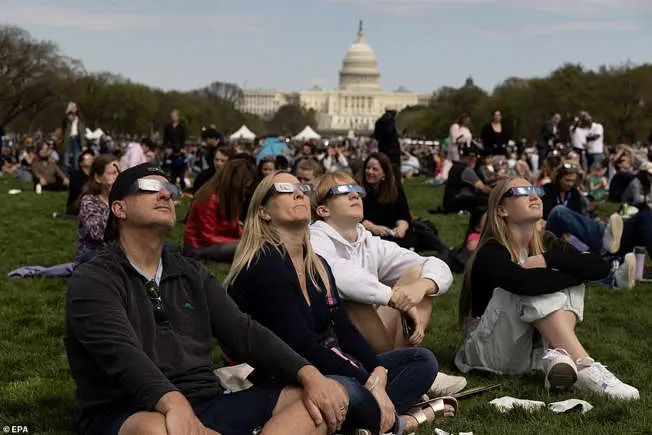A young woman has detailed her struggle with impaired vision and difficulty reading over six years after staring directly into the 2017 solar eclipse.
The young woman, Bridget Kyeremateng, 29, said she covered one eye and looked at the eclipse for about 10 to 15 seconds through the other eye without wearing protective glasses.
When she woke up and looked at her phone, she noticed a gaping blind spot in her left eye, making it impossible to read every other word on her phone and recognize traffic signs.
A visit with an optometrist confirmed that she had irrevocably damaged her eyes, leading to migraines, blurry and distorted vision, and white dots appearing in her left line of sight.
Staring at the sun on any day is risky, as it can burn the retinas and cause lasting vision damage. While some may believe looking at an obscured sun is less risky, optometrists have still cautioned that the sun’s rays peaking out around the moon’s perimeter can be just as dangerous.

Bridget Kyeremateng, 29, warned fellow eclipse-gazers not to look at the sun as she did six years ago during the last solar eclipse, which left her with a burned retina and irreversible vision damage© Provided by Daily Mail

Eclipse-watchers were told to wear special glasses approved by the International Organization for Standardization (ISO), which are about 100 times darker than normal sunglasses© Provided by Daily Mail
The damage from staring at the eclipse may not be evident right away. Because there are no pain receptors at the back of the eyes, a stargazer may not register the damage they’ve inflicted on their vision until hours pass.

On Monday, April 8th, around 32 million Americans were lucky enough to see the total solar eclipse from Earth. The rare event occurred as the moon moved directly between the sun and the Earth, resulting in some amazing photo opportunities.©Jody Cortes/Shutterstock
In Ms Kyeremateng’s case, she noticed something was amiss the next morning.
She opened her phone upon waking and noticed she could only read about every other word on the screen, and chalked it up to still being tired and groggy.
But after walking around her home and waking up more fully, the problem lingered.
‘There was like a blind spot on every other word that I was reading… I couldn’t see things. And I said, “Oh my god”.
‘Started driving to the eye doctor, and couldn’t see the signs. This all happened in a span of 10 seconds; only 10 seconds I looked at the sun.’
Once retina tissue is destroyed, it doesn’t regenerate, so the damage that the Brooklyn native and likely thousands of other Americans who looked directly at the eclipse sustained is irreversible.

Google searches of ‘vision damage’ spiked yesterday afternoon during and after the solar eclipse, suggesting many people woke up Tuesday morning with some eye strain© Provided by Daily Mail
The allure to look at the celestial wonder in 2017 left an unknown number of Americans with impaired vision the next day.
How to tell if it could have damaged your eyes from the solar eclipse
An estimated 32million people enjoyed one of the most spectacular sights visible from the Earth without proper precautions, like special eclipse glasses, and spectators could have permanently damaged their eyes, experts warned.
Roughly 100 individuals in the US and Canada reported to eyecare professionals after the August 21, 2017 solar eclipse complaining of eclipse-related retina damage, according to an informal survey for the American Astronomical Society.
Google searches about ‘hurt eyes’ and ‘vision damage’ spiked on Monday afternoon, just after many Americans took in the brief wonder.
Bright sunlight can damage the macula, the center of the retina that allows us to see the road while we drive, read text, and recognize faces.
The peripheral vision will likely be fine, but the damage affects the central vision system.
Dr Vicki Chan, a Los Angeles-based ophthalmologist, said: ‘Just like a magnifying lens pointed at the sun can burn holes in paper, the lens in your eye can focus the sunlight to burn holes in your retina.’
Doctors told her she has slow 20/20 vision, meaning she can still see objects at a distance of 20 feet as clearly as an average person, but it takes longer for her brain to process what it’s seeing or reading.
The blind spot in her vision remains, though she can see wearing prescription eyeglasses and sunglasses when she goes outside.
She said the issue affected her day to day life in the first six months or so after looking at the eclipse, but added: ‘My eyes know what to do now and I wear prescription sunglasses.’
San Miguel Times
Newsroom

